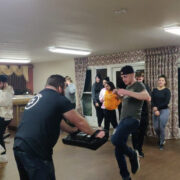
The message Moses brought was twofold: You will be redeemed from slavery, and just as importantly, you will be given the strength to reconcile your inner being with every moment of trauma and abuse.(This Friday night, Jews around the world will once again sit at the seder table and retell the Passover narrative—the dramatic story of how a powerless Jewish slave nation was miraculously redeemed, set free from Egypt and eventually claimed the land of Israel as its own.
But was the exodus from Egypt actually the moment when the Jewish people achieved freedom? That is what conventional wisdom tells us. In actuality, however, the story of the Jewish people is a far more complex and interconnected web of survival, freedom and redemption. It is a millennia-long journey whose climax was not necessarily freedom from slavery in Egypt, but ongoing redemption through emergence from trauma.Subscribe to The JNS Daily Syndicate by email and never miss our top stories
My vivid memories of Passover seder nights stretch back to the 1950s. Many hours in all stages of my life were spent discussing freedom. Yet this year, the story I will tell my children and grandchildren will be different, revised in light of getting to know two inspirational Holocaust survivors from my local Jewish community in San Diego: Dr. Edith Eger and Fanny Krasner Lebovits.
Each of these survivors has written books detailing their lives, but you really need to sit down and speak with them to begin to capture their joyful, vibrant spirit. Eger, 92, is a practicing psychologist and international speaker. Lebovits, 96, is the matriarch of a vibrant and growing multigenerational family which, she advises, guides and leads with much love. These women did more than survive the Holocaust. They emerged from unspeakable trauma and embraced life, family and adventure with verve.
Why will I tell the stories of Holocaust survivors this Passover?
First, the further away we move from the Nazi atrocities, the more the Holocaust fades from memory. The most recent comprehensive study on Holocaust awareness conducted by Schoen Consulting and commissioned by the Conference on Jewish Material Claims Against Germany revealed that 31 percent of Americans believe that 2 million Jews or fewer (not the actual figure of 6 million) were killed in the Holocaust, while 41 percent do not know what Auschwitz (the deadliest of the Nazi concentration camps) was. As a future era without living survivors of the Holocaust approaches, retelling survivors’ stories as much as we can today will ensure that the memories of the Holocaust will live on tomorrow—much like retelling the Passover story each year has effectively preserved that narrative.
Second, juxtaposing the stories of liberation from the Holocaust with the Passover story’s 10 plagues, exodus and splitting of the Red Sea serves to underscore what it takes to become free. Simply walking out of Egypt (or Auschwitz) does not enable a person to live or feel free. Too much trauma and damage have taken place. It takes a personal reckoning with every moment of suffering—staring into the faces of evil that until now tormented you and proclaiming that although that suffering will never be forgotten, its hold over you has ended. That is exactly what comprises the inspiring backstory of Holocaust survivors Eger and Lebovits, and it is also the crux of the process of redemption that is detailed in the Passover Haggadah and that continues to unfold today.
Eger, already an authority in treating trauma, in 1981 accepted an invitation to speak at a military conference for chaplains in Berchtesgaden, Bavaria—a retreat used by Hitler. She ended up sleeping in the former bed of none other than Nazi propaganda minister Joseph Goebbels.
Lebovits, months after liberation and while working for a U.N. agency, confronts a ghetto guard who pleads with her not to turn him in. She chooses to be compassionate and walks away from him, quieting a thirst for revenge.
Those are just two of countless moments of reckoning in the heroic lives of these two women. Recounting such moments makes it possible to vividly preserve the memory of the Holocaust, yet simultaneously to live lives that look forward rather than remaining captured by the past.
Much of this sentiment can be understood by the simple sign given to Moses at the burning bush when he is tasked by G-d to lead the Jewish people out of Egypt. He is told that every moment of suffering in Egypt was considered carefully by G-d, and that no outcry went unheard. The message Moses brought was twofold: You will be redeemed from slavery, and just as importantly, you will be given the strength to reconcile your inner being with every moment of trauma and abuse. Only by doing both would it be possible for these former slaves to walk the road towards spiritual and personal freedom.
This Friday night, I will retell this ongoing journey from survival to freedom to redemption, from the dual lenses of the Passover story, as well as the Holocaust and its aftermath. It is not a story of the gates being flung open and the Jewish people marching out as freed men and women. Rather, it’s the story of a people emerging from trauma with the temerity to consider and confront all that they had been through, and by doing so, moving on to lead lives based on compassion and justice in harmony with all others.
Redemption has never looked so real or so magnificent.
Rabbi Simcha Weiser is head of school at Soille San Diego Hebrew Day School.







Comments